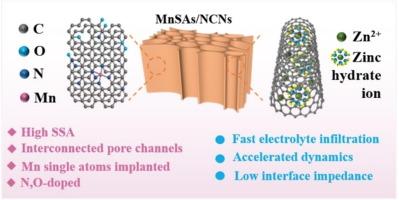“One stone, two birds”: Salt template enabling porosity engineering and single metal atom coordinating toward high-performance zinc-ion capacitors
IF 13.1
1区 化学
Q1 Energy
引用次数: 0
Abstract
Zinc-ion hybrid capacitors (ZIHCs) have received increasing attention as energy storage devices owing to their low cost, high safety, and environmental friendliness. However, their progress has been hampered by low energy and power density, as well as unsatisfactory long-cycle stability, mainly due to the lack of suitable electrode materials. In this context, we have developed manganese single atoms implanted in nitrogen-doped porous carbon nanosheets (MnSAs/NCNs) using a metal salt template method as cathodes for ZIHCs. The metal salt serves a dual purpose in the synthesis process: It facilitates the uniform dispersion of Mn atoms within the carbon matrix and acts as an activating agent to create the porous structure. When applied in ZIHCs, the MnSAs/NCNs electrode demonstrates exceptional performance, including a high capacity of 203 mAh g−1, an energy density of 138 Wh kg−1 at 68 W kg−1, and excellent cycle stability with 91% retention over 10,000 cycles. Theoretical calculations indicate that the introduced Mn atoms modulate the local charge distribution of carbon materials, thereby improving the electrochemical property. This work demonstrates the significant potential of carbon materials with metal atoms in zinc-ion hybrid capacitors, not only in enhancing electrochemical performance but also in providing new insights and methods for developing high-performance energy storage devices.

"一石二鸟盐模板可实现多孔性工程和单金属原子协调,从而实现高性能锌离子电容器
锌离子混合电容器(ZIHC)因其低成本、高安全性和环境友好性而作为储能设备受到越来越多的关注。然而,由于缺乏合适的电极材料,锌离子混合电容器的发展一直受到能量和功率密度低以及长周期稳定性不理想的阻碍。在此背景下,我们采用金属盐模板法,开发了植入氮掺杂多孔碳纳米片(MnSAs/NCNs)中的锰单原子,作为 ZIHC 的阴极。金属盐在合成过程中具有双重作用:它有助于锰原子在碳基质中的均匀分散,并作为活化剂形成多孔结构。当应用于 ZIHC 时,MnSAs/NCNs 电极表现出了卓越的性能,包括 203 mAh g-1 的高容量、68 W kg-1 时 138 Wh kg-1 的能量密度,以及卓越的循环稳定性(10000 次循环保持率为 91%)。理论计算表明,引入的锰原子调节了碳材料的局部电荷分布,从而改善了电化学性能。这项研究表明,含有金属原子的碳材料在锌离子混合电容器中具有巨大潜力,不仅能提高电化学性能,还能为开发高性能储能器件提供新的见解和方法。
本文章由计算机程序翻译,如有差异,请以英文原文为准。
求助全文
约1分钟内获得全文
求助全文
来源期刊

Journal of Energy Chemistry
CHEMISTRY, APPLIED-CHEMISTRY, PHYSICAL
CiteScore
19.10
自引率
8.40%
发文量
3631
审稿时长
15 days
期刊介绍:
The Journal of Energy Chemistry, the official publication of Science Press and the Dalian Institute of Chemical Physics, Chinese Academy of Sciences, serves as a platform for reporting creative research and innovative applications in energy chemistry. It mainly reports on creative researches and innovative applications of chemical conversions of fossil energy, carbon dioxide, electrochemical energy and hydrogen energy, as well as the conversions of biomass and solar energy related with chemical issues to promote academic exchanges in the field of energy chemistry and to accelerate the exploration, research and development of energy science and technologies.
This journal focuses on original research papers covering various topics within energy chemistry worldwide, including:
Optimized utilization of fossil energy
Hydrogen energy
Conversion and storage of electrochemical energy
Capture, storage, and chemical conversion of carbon dioxide
Materials and nanotechnologies for energy conversion and storage
Chemistry in biomass conversion
Chemistry in the utilization of solar energy
 求助内容:
求助内容: 应助结果提醒方式:
应助结果提醒方式:


